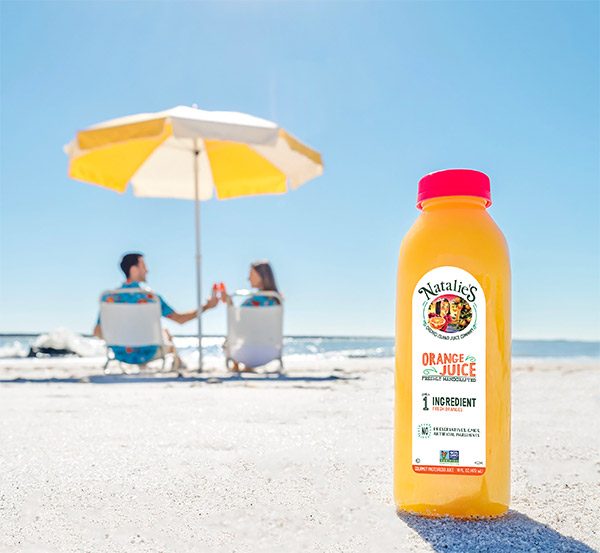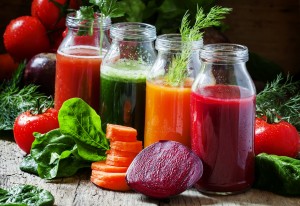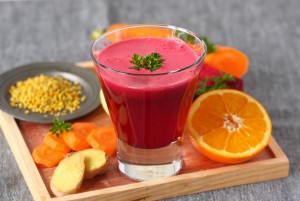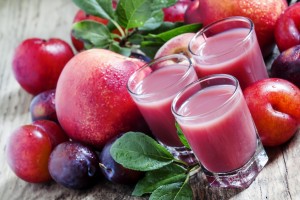Natalie’s featured on Epoch Times
The Red Juice Trend Is Hot This Summer
Date: June 20th, 2016With the arrival of summer’s hot temperatures, a desire for the cooling quality that fresh juices bring to the body is more strong than ever.
While the earthy-flavored green juices tend to be the most popular, imagine that a change of color could open up a whole new world of exploration.
Natalie Sexton, of Florida-based Natalie’s Orchid Island Juice Co., says their fastest growing products are the red juices.
“People became so tunnel vision on green that they forget that there is a whole spectrum of fruits and vegetables that we can take,” she said in a recent telephone interview.
For example, have you ever tried an all-natural tomato juice? Natalie’s makes one from crushed tomatoes. It is so pure you may find a seed hiding in the bottom of your thick, refreshingly light drink.
“People are shocked at what a fresh tomato juice tastes like. – Natalie Sexton, director of marketing, Natalie’s Orchid Island Juice Co.
Natalie, who is in charge of marketing for her eponymous family business, was in New York recently as part of a Northeast summer road trip, re-introducing people to tomato juice.
“People are shocked at what a fresh tomato juice tastes like,” she said, “because they think it is suppose to be salty.”
Most people are familiar with the mainstream brands, such as Campbell’s V8 tomato juices, or Mott’s Clamato juices, which are often associated with what’s used to mix alcoholic drinks like Bloody Marys.
Both are made with reconstituted juice or juice from concentrate, and contain natural and artificial flavorings.
Nutrient-Packed
Natalie is passionate about the importance of using quality ingredients and keeping a clean label.
“If you are a true foodie and you want to know about the nutritional value of a product, look at the shelf life. – Natalie Sexton, marketing, Natalie’s Orchid Island Juice Company
“We are literally having to reeducate the consumers about what they perceive a tomato to be,” said Natalie. “Oh my, this is what a tomato is suppose to taste like!” people will say.
Of Natalie’s 12 juice flavors, all are made with freshly squeezed fruit, and contain from 1–4 ingredients. They are also minimally processed, with an approximately 26-day shelf life.
“If you are a true foodie and you want to know about the nutritional value of a product, look at the shelf life,” explains Natalie, adding that a short shelf life tells the consumer the product still contains health-promoting live enzymes.
Another popular red juice flavor is Natalie’s orange beet juice, which is made from mashed up whole beets, and freshly squeezed Florida oranges.
The idea for the flavor came from Natalie’s mother Marygrace Sexton, founder of the company she named after her daughter. Marygrace is a cyclist, and one day her coach recommended that she drink beet juice to increase oxygen in the blood. He said it helps the body recover after exercising.
But Marygrace could not find any products on the market that met her high standards, so she decided to make her own. If you love juice, and you are looking to improve your health, it sure helps to own a juice company!
Strawberry lemonade, which is another red juice, is also super popular this summer, according to Natalie. This product has 20 percent fresh-squeezed lemon juice, which is very high compared to most others on the market.
San Pellegrino’s Limonata soda, for example, which is prized for its high juice content, contains just 18 percent juice, and this juice is from concentrate.
Lemons are loaded with health benefits. Fresh lemon juice may lower your risk of a stroke, fight damaging free radicals associated with cancer, help you to maintain a healthy complexion, and boost the immune system, according to Medical News Today.
Make Your Own
Of course, if you want to ensure the highest quality nutrition from your juice, the best bet is to make it yourself.
Popular ingredients used to make red juice mainly fall into two categories: fruits and vegetables.
Commonly used fruits include strawberries, watermelons, plums, cherries, cranberries, raspberries, and pomegranates.
Commonly used vegetables include beets, carrots, apples, radish, red peppers, and cucumbers.
Greens are often added too, such as dandelion greens, kale, or spinach, which can help to balance the sweetness of the fruits.
Ginger and lemon or lime are other popular ingredients that add pungency and sour tastes respectively. Another idea is to add a touch of cayenne pepper for underlying heat. Or add sunflower, flax, or chia seeds for an added boost of healthy fats.
While fresh juice is generally considered part of a healthy diet, it is important to remember that it can still contain a significant number of calories, mainly from natural sugars.
A 16-ounce juice could be as many as 400 calories, which would be like a meal replacement based on a 2,000 calorie daily diet.
If you want to know for sure, the USDA has an amazing database of nutritional information that you can use to calculate the calories (and other nutrition facts) of your own favorite juice recipe.
Some great red juice recipes can be found here, here, and here.
http://www.theepochtimes.com/n3/2096066-the-red-juice-trend-is-hot-this-summer/





